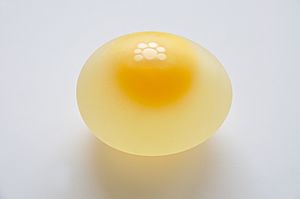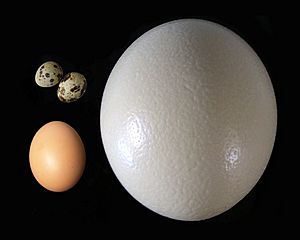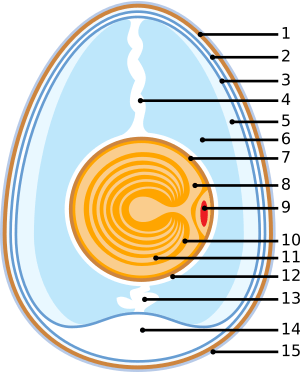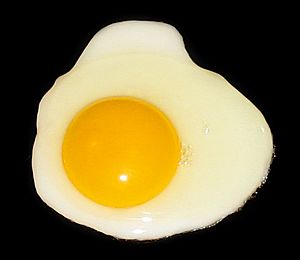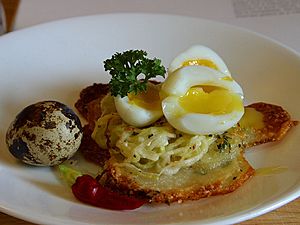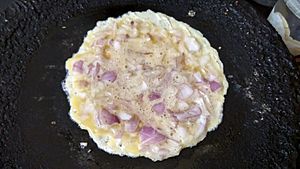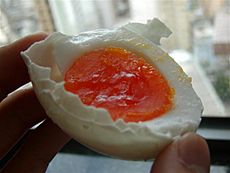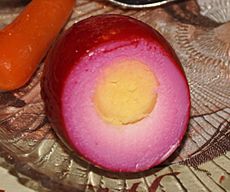Egg (food) facts for kids
Most eggs that people eat, like those from birds and turtles, have a hard, oval eggshell. Inside, there's the albumen (which is the egg white), the vitellus (the egg yolk), and some thin layers like skin. Almost every part of an egg can be eaten, though the shell is usually thrown away. Eggs are a great source of protein and choline, which are important for your body.
Roe and caviar are special kinds of edible eggs that come from fish.
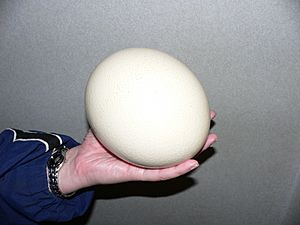
Contents
History of Eggs
People have been eating bird eggs for a very long time, even before history was written down. They were important for both hunting groups and later for cultures that raised birds. Chickens were probably first raised for their eggs in Southeast Asia and India before 7500 BCE.
Chickens arrived in ancient Sumer and Egypt by 1500 BCE, and in Greece around 800 BCE. Before chickens, quail eggs were the main source of eggs in Greece. In ancient Egypt, around 1420 BCE, a tomb painting shows a man carrying bowls of ostrich eggs and other large eggs as gifts.
In ancient Rome, people used different ways to keep eggs fresh. Meals often started with an egg dish. The Romans would even crush eggshells on their plates to stop bad spirits from hiding there! During the Middle Ages, people were not allowed to eat eggs during Lent because eggs were seen as a rich food. The word mayonnaise might even come from an old French word, moyeu, which meant yolk or center.
In the 1600s, scrambled eggs mixed with sour fruit juices became popular in France. This might be how lemon curd started.
The industry for dried eggs began in the 1800s. In 1878, a company in St. Louis, Missouri started turning egg yolks and whites into a dry, meal-like powder. Making dried eggs became much bigger during World War II. The United States military and its allies used them a lot.
In 1911, Joseph Coyle invented the egg carton in Smithers, British Columbia. He created it to help solve arguments about broken eggs between a farmer and a hotel owner. The first egg cartons were made of paper.
Different Kinds of Eggs
Bird eggs are a very common food and are used in many different ways in cooking. They are a big part of the modern food industry.
The eggs people eat most often come from chickens. Duck and goose eggs are also eaten, and smaller eggs like quail eggs are sometimes used as a special ingredient in Western countries. Eggs are an everyday food in many parts of Asia, like China and Thailand. In fact, Asia produced 59% of the world's eggs in 2013.
The largest bird eggs, from ostriches, are usually only eaten as a special, fancy food. Gull eggs are a special treat in England and some Scandinavian countries, especially Norway. In some African countries, guineafowl eggs are often sold in markets, especially in spring. Pheasant eggs and emu eggs can also be eaten, but they are harder to find. You might get them from farmers or special grocery stores. In many countries, laws protect wild birds' eggs, so collecting or selling them is not allowed, or only allowed at certain times of the year.
How Eggs are Produced
In 2013, the world produced 68.3 million tonnes of chicken eggs. The biggest producers were China (24.8 million tonnes), the United States (5.6 million), India (3.8 million), and Japan (2.5 million). A large egg farm can send out a million dozen eggs every week!
During production, eggs are usually checked for quality using a process called candling. Depending on local rules, they might be washed before being put into egg boxes.
Egg Parts and Features
An egg is shaped like a stretched-out ball, with one end bigger than the other. It has a thin, hard shell around it. Inside, the egg yolk floats in the egg white. It's held in place by one or two spiral bands of tissue called chalazae. These look like hard lumps.
Air Cell
The bigger end of the egg has an air cell. This forms when the egg cools down and shrinks after it is laid. Chicken eggs are sorted by how big this air cell is, which is measured during candling. A very fresh egg has a small air cell and gets an "AA" grade. As the air cell gets bigger and the egg's quality goes down, the grade changes from AA to A to B.
You can also test how old an egg is this way: as the air cell grows (because air comes through tiny holes in the shell as water leaves), the egg becomes less heavy. If you put the egg in a bowl of water, the bigger end will float higher and higher. A very old egg will actually float on top of the water and should not be eaten.
Shell
The color of an eggshell comes from pigments added while the egg is forming inside the bird. The color can change depending on the species and breed of bird. Colors range from common white or brown to pink or even speckled blue-green. Generally, chicken breeds with white earlobes lay white eggs, while chickens with red earlobes lay brown eggs.
The shell color doesn't change how nutritious the egg is. However, people often prefer one color over another for cultural reasons. Brown eggs are more likely to have small blood spots inside, because it's harder to see them during candling.
Membrane
The membrane is a clear, thin film that lines the eggshell. You can see it when you peel a boiled egg. This membrane is mostly made of strong proteins like collagen.
White
The egg white is the clear liquid inside an egg, also called albumen. In chickens, it forms from layers of liquid added as the egg travels through the hen's body. It forms around both fertilized and unfertilized yolks. The main natural job of the egg white is to protect the yolk and give extra food for the growing embryo.
Egg white is mostly water (about 90%). The other 10% is proteins. Unlike the yolk, which has a lot of fat, egg white has almost no fat and less than 1% carbohydrates. Egg white is used in many foods and for other things, like making vaccines for the flu.
Yolk
The yolk in a freshly laid egg is round and firm. As the egg gets older, the yolk soaks up water from the egg white. This makes the yolk bigger and stretches and weakens the vitelline membrane, which is the clear skin around the yolk. This causes the yolk to become flatter and larger.
The color of the yolk depends on what the hen eats. If the hen's food has yellow or orange plant pigments called xanthophylls, these colors are stored in the yolk. Lutein is the most common pigment in egg yolks. If a hen eats food with no color, the yolk can be almost colorless. For example, feeding hens yellow corn or marigold petals makes the yolk color stronger. In the US, it's not allowed to use artificial colors to change yolk color.
Abnormalities
Sometimes, eggs can have problems like being shell-less or having very thin shells. This can be caused by something called egg drop syndrome.
How Eggs are Used in Cooking
Types of Dishes
Chicken eggs are used a lot in many different kinds of dishes, both sweet and savory, including many baked goods. Some common ways to cook them are scrambled, fried, poached, hard-boiled or soft-boiled, and in omelettes. They can also be pickled.
Eating raw eggs is not usually recommended, especially for people who might get sick easily, like older people, sick people, or pregnant women. Also, your body can only use about 51% of the protein in raw eggs, but almost twice as much (about 91%) from cooked eggs.
Egg yolks are important for making foods smooth and creamy, like in custards, and they help thicken things.
The albumen, or egg white, has protein but very little or no fat. It can be used separately from the yolk in cooking. The proteins in egg white allow it to form foams and light, airy dishes. Egg whites can be whipped until they are light and fluffy. They are often used in desserts like meringues and mousse.
Sometimes, ground eggshells are used as a food additive to add calcium. As mentioned, almost every part of an egg can be eaten, even though the shell is usually thrown away. Some recipes even use immature eggs that are still inside the chicken after it's prepared.
Cooking Tips
Eggs have many proteins that firm up at different temperatures in the yolk and the white. The temperature affects how long it takes for them to set. Egg yolk becomes firm between 65 and 70 degrees Celsius (149-158°F). Egg white sets at temperatures from 60 to 73 degrees Celsius (140-163°F). Often, the white sets first because it gets hotter for longer.
Salmonella bacteria are killed instantly at 71 degrees Celsius (160°F). They can also be killed at 54.5 degrees Celsius (130°F) if held at that temperature for a long enough time. To avoid salmonella, eggs can be pasteurized in their shells at 57 degrees Celsius (135°F) for about an hour and 15 minutes. The white might look a little milky, but the eggs can still be used normally. Whipping them for meringue takes longer, but the final amount is almost the same.
If a boiled egg is cooked for too long, a greenish ring might appear around the yolk. This happens because of the iron and sulfur in the egg. It can also happen if there's a lot of iron in the cooking water. The green ring doesn't change the egg's taste, but overcooking can make the protein less good. To stop the green ring from forming, cool the egg in cold water for a few minutes until it's completely chilled.
It's easiest to peel a cooked egg if you put it into boiling water, rather than slowly heating it in cold water.
Flavor Changes
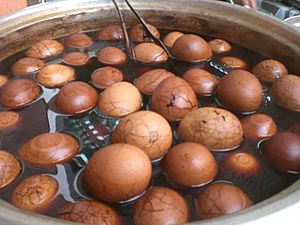
While how old an egg is and how it's stored affect its flavor more, what the bird eats also changes the egg's taste. For example, if a brown-egg chicken eats rapeseed or soy, its gut bacteria can turn these into a fishy-smelling chemical, which ends up in the egg. Eggs from free-range hens, who eat whatever they find, can have unpredictable flavors. Duck eggs taste different from chicken eggs, but still similar.
Eggs can also soak up flavors from mixtures. Tea eggs, for instance, are steeped in a brew of spices, soy sauce, and black tea leaves to give them flavor.
Storing Eggs
Storing edible eggs carefully is very important. If an egg is not handled properly, it can have high levels of Salmonella bacteria, which can cause serious food poisoning. In the US, eggs are washed. This cleans the shell but removes a natural protective layer. So, the US Department of Agriculture (USDA) suggests keeping eggs in the fridge to stop Salmonella from growing.
Refrigeration also helps keep the taste and texture good. However, whole, uncracked eggs can stay fresh for several months without being refrigerated. In Europe, eggs are usually not washed, so their shells might be dirtier, but their natural protective layer is still there. Because of this, they don't need to be refrigerated. In the UK, hens are vaccinated against salmonella, and the eggs are generally safe for 21 days.
Preserving Eggs
The simplest way to preserve an egg is to treat it with salt. Salt pulls water out of bacteria and molds, which stops them from growing. The Chinese salted duck egg is made by soaking duck eggs in salty water, or by covering them with a paste of salt and mud or clay. The eggs stop soaking up salt after about a month. Their yolks turn orange-red and become firm, but the white stays a bit liquid. They are often boiled before eating and served with rice congee.
Another way to preserve eggs is to make pickled eggs. First, you boil them, then soak them in a mix of vinegar, salt, and spices like ginger or allspice. Often, beetroot juice is added to make the eggs red. If the eggs are soaked for a few hours, you can see distinct red, white, and yellow colors when they are sliced. If they soak for several days or more, the red color will reach the yolk. If they soak for several weeks or more, the vinegar will dissolve much of the shell's calcium carbonate and get inside the egg. This makes the egg acidic enough to stop bacteria and molds from growing. Pickled eggs made this way can usually last for a year or more without needing to be refrigerated.
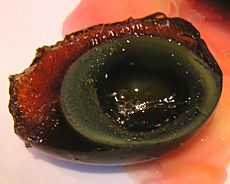
A century egg (or hundred-year-old egg) is preserved by covering an egg in a mix of clay, wood ash, salt, lime, and rice straw for several weeks to several months. After this process, the yolk becomes a dark green, creamy substance with a strong smell of sulfur and ammonia. The white turns into a dark brown, clear jelly with a milder, unique flavor. The main thing that changes the egg in a century egg is the alkaline material, which slowly raises the egg's pH level. This chemical process breaks down some of the complex proteins and fats in the yolk into simpler, more flavorful ones. It's like an "inorganic" version of fermentation.
Egg Substitutes for Cooking
For people who don't eat eggs, there are other things to use in baking. These include things that help dough rise or bind ingredients together, like ground flax seeds or potato starch flour. Tofu can also help bind things because it has a lot of lecithin from soy. Applesauce, arrowroot, and banana can also be used.
Extracted soybean lecithin is often used in packaged foods as a cheaper replacement for egg lecithin. Liquids from cooked legumes, like chickpea brine or green pea canning liquid (also known as aquafaba), can replace egg whites in desserts like meringues and mousses.
Other egg substitutes are made only from egg whites for people who are worried about the high cholesterol and fat in whole eggs. These products usually have added vitamins and minerals, as well as plant-based thickeners like xanthan gum or guar gum. These help the product keep the nutrition and cooking properties of real eggs, making it possible to create foods like Hollandaise sauce, custards, mayonnaise, and most baked goods with these substitutes.
Nutritional Value
| Nutritional value per 100 g (3.5 oz) | |
|---|---|
| Energy | 647 kJ (155 kcal) |
|
1.12 g
|
|
|
10.6 g
|
|
|
Protein
|
12.6 g
|
| Tryptophan | 0.153 g |
| Threonine | 0.604 g |
| Isoleucine | 0.686 g |
| Leucine | 1.075 g |
| Lysine | 0.904 g |
| Methionine | 0.392 g |
| Cystine | 0.292 g |
| Phenylalanine | 0.668 g |
| Tyrosine | 0.513 g |
| Valine | 0.767 g |
| Arginine | 0.755 g |
| Histidine | 0.298 g |
| Alanine | 0.700 g |
| Aspartic acid | 1.264 g |
| Glutamic acid | 1.644 g |
| Glycine | 0.423 g |
| Proline | 0.501 g |
| Serine | 0.936 g |
| Vitamins | Quantity
%DV†
|
| Vitamin A equiv. |
19%
149 μg |
| Thiamine (B1) |
6%
0.066 mg |
| Riboflavin (B2) |
42%
0.5 mg |
| Niacin (B3) |
0%
0.064 mg |
| Pantothenic acid (B5) |
28%
1.4 mg |
| Vitamin B6 |
9%
0.121 mg |
| Folate (B9) |
11%
44 μg |
| Vitamin B12 |
46%
1.11 μg |
| Choline |
60%
294 mg |
| Vitamin D |
15%
87 IU |
| Vitamin E |
7%
1.03 mg |
| Vitamin K |
0%
0.3 μg |
| Minerals | Quantity
%DV†
|
| Calcium |
5%
50 mg |
| Iron |
9%
1.2 mg |
| Magnesium |
3%
10 mg |
| Phosphorus |
25%
172 mg |
| Potassium |
4%
126 mg |
| Sodium |
8%
124 mg |
| Zinc |
11%
1.0 mg |
| Other constituents | Quantity |
| Water | 75 g |
| Cholesterol | 373 mg |
|
For edible portion only.
Refuse: 12% (shell). An egg just large enough to be classified as "large" in the US yields 50 grams of egg without shell. This size egg is classified as "medium" in Europe and "standard" in New Zealand. Link to USDA Database entry |
|
| †Percentages estimated using US recommendations for adults. | |
Chicken eggs, which are the most commonly eaten, give you 155 calories of energy and 12.6 grams of protein in a 100-gram serving.
Boiled eggs provide many important vitamins and minerals. For example, a 100-gram serving of a hard-boiled egg gives you a good amount of vitamin A (19% of what you need daily), riboflavin (42%), pantothenic acid (28%), vitamin B12 (46%), choline (60%), phosphorus (25%), zinc (11%), and vitamin D (15%).
A yolk contains more than two-thirds of the daily suggested amount of 300 mg of cholesterol.
What laying hens eat can change how nutritious their eggs are. For example, chicken eggs that are high in omega-3 fatty acids are produced by feeding hens foods with certain fats, like fish oil, chia seeds, or flaxseeds. Hens raised on pasture, who find their own food, also lay eggs that have more omega-3 fatty acids compared to chickens raised in cages.
A 2010 study by the USDA found no big differences in the main nutrients in different chicken eggs. Cooked eggs are easier to digest and have a lower risk of salmonellosis.
Health Effects of Eggs
Cholesterol and Fat
More than half of the calories in eggs come from the fat in the yolk. A 50-gram chicken egg (a large egg in the US) has about 5 grams of fat. People on a low-cholesterol diet might need to eat fewer eggs. However, only about 27% of the fat in an egg is saturated fat. The egg white is mostly water (87%) and protein (13%), and it has no cholesterol and very little fat.
There is some discussion about whether egg yolk is bad for your health. Some research suggests that the cholesterol you eat can affect your body's cholesterol levels. But other studies show that eating a moderate amount of eggs (up to one a day) doesn't seem to increase the risk of heart disease in healthy people. Some experts argue that the fat in eggs, especially saturated fat, is more likely to raise cholesterol levels than the cholesterol itself.
Type 2 Diabetes
Studies have shown different results about a possible link between eating eggs and Type 2 diabetes. A 1999 study of over 117,000 people suggested that eating more eggs might increase the risk of heart disease in people with diabetes. A 2008 study also found that eating eggs daily was linked to a higher risk of type 2 diabetes. However, a study in 2010 found no link between eating eggs and type 2 diabetes.
A review of many studies from 2013 found that eating 4 eggs per week was linked to a 29% higher risk of getting diabetes. Another review from 2013 also supported the idea that eating eggs might lead to more cases of type two diabetes.
Heart Health Risk
Eggs are one of the biggest sources of a substance called phosphatidylcholine in our diet. A study showed that bacteria in our gut break down phosphatidylcholine, turning it into a compound called TMAO. This compound has been linked to an increased risk of heart disease.
The 1999 study mentioned earlier, which looked at over 117,000 people, concluded that eating up to 1 egg per day probably doesn't have a big effect on the risk of heart disease or stroke in healthy people. However, a study of 4,000 people found that eating eggs increased blood levels of TMAO, which then led to a much higher risk of heart attack and stroke after three years.
A 2007 study of almost 10,000 adults found no link between eating a moderate amount of eggs (six per week) and cardiovascular disease or strokes. The only exception was in people with diabetes, who showed an increased risk of heart disease. A 2013 review of many studies found no link between eating eggs and heart disease or stroke. However, another 2013 review found that people with type 2 diabetes who ate more than one egg daily had a 1.69 times higher risk of heart disease compared to those with type 2 diabetes who ate less than one egg per week. Another 2013 review found that eating 4 eggs per week increased the risk of heart disease by 6%.
Food Allergies
One of the most common food allergies in babies is to eggs. Babies usually grow out of this allergy during childhood if they don't eat eggs often. Allergic reactions to egg whites are more common than reactions to egg yolks.
Besides true allergic reactions, some people have a food intolerance to egg whites. In most developed countries, food labels now include eggs, egg products, and a warning if foods were made on equipment that also processes foods with eggs. This is usually in a special allergen alert section on the label.
Egg Farming
Most chicken eggs sold for people to eat are not fertilized. This is because the hens that lay them are kept without roosters. Fertilized eggs can be eaten, and they have very little nutritional difference from unfertilized ones. Fertilized eggs won't have a developed embryo because cold temperatures stop cell growth for a long time. Sometimes, an embryo is allowed to develop but is eaten before hatching, like with balut.
Washing and Refrigeration
In North America, laws require eggs to be washed and kept in the fridge before being sold. This is to remove natural dirt from farms and stop bacteria from growing. In Europe, the laws are the opposite. Washing removes the natural protective layer on the egg, and putting eggs in the fridge can cause water to form on the shell, which might help bacteria grow.
Egg Color
There is no difference in taste or nutrition between white and brown eggs. The color of a chicken's egg depends on the breed of the chicken.
In most of the United States, eggs are usually white. But in the northeast US and in the United Kingdom, eggs are usually light brown. People in Brazil and Poland prefer brown or reddish eggs because white eggs are sometimes seen as "industrial," meaning they are used in commercial bakeries. The reason some people prefer one egg color over another is probably because of what those colors make them think of. For example, white might be linked to purity, and brown shells to being more natural or wholesome.
Related pages
Images for kids
-
A fried chicken egg, sunny side up
-
Hanácké kraslice, Easter eggs from the Haná region, the Czech Republic.
See also
 In Spanish: Huevo (alimento) para niños
In Spanish: Huevo (alimento) para niños



